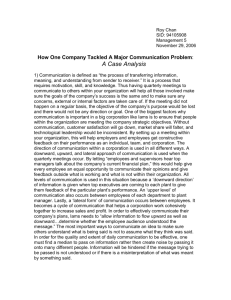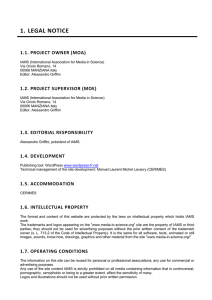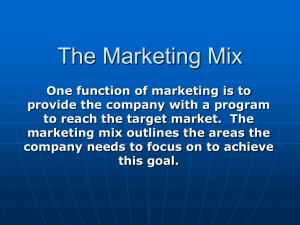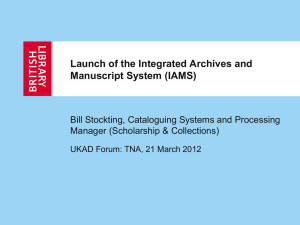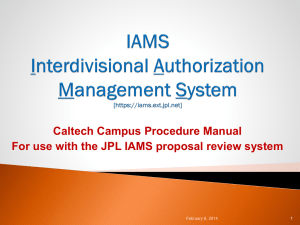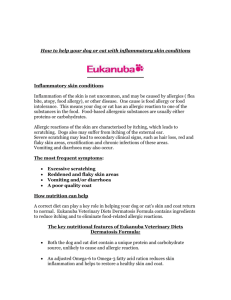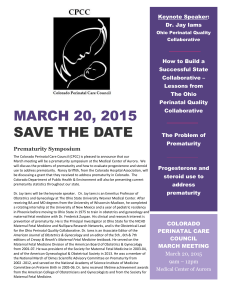iAMS Presentation
advertisement
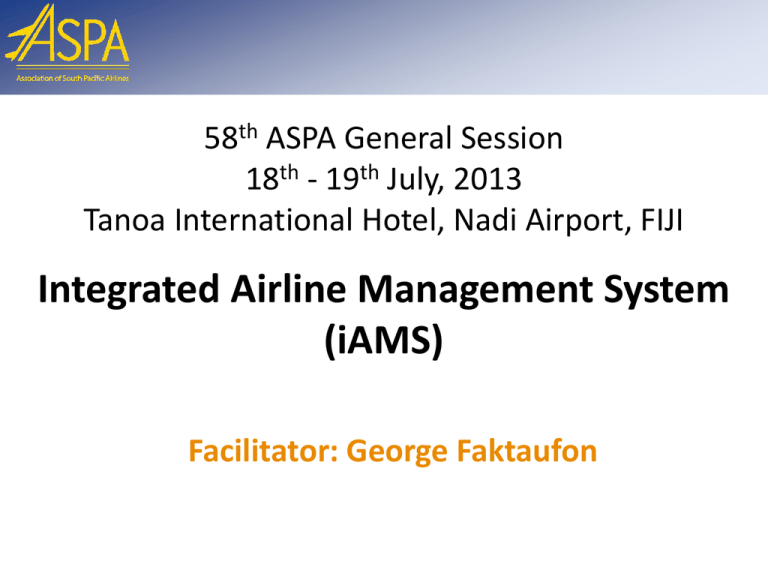
58th ASPA General Session 18th - 19th July, 2013 Tanoa International Hotel, Nadi Airport, FIJI Integrated Airline Management System (iAMS) Facilitator: George Faktaufon Presentation Objective • Understand the Integrated Aviation Management System, focusing on business performance and profitability, by complying with aviation quality, safety and security standards, using world class management tools, techniques and best practices Integrated Management Aviation System Business Orientation • Customer focus • Competitiveness – Capacity – Capability • Competitors • Systems & Processes • Profitability (Based on Cost - not only revenues) – (Efficiency - do more with less) Aviation Management • • • • • • • • System approach Processes as System DNA Performance based Driven by people´s competence Accomplishment of requirements Preventive in nature Integrating Human Factors People Management Development for Airlines Aviation Management SAFE & EFFICIENT AIRCRAFT OPERATIONS QUALITY Compliance Efficiency SAFETY (SMS) SECURITY (AVSEC) Prevent Aircraft Accidents & Incidents Protect against Illegal interference PREVENTION Management Objectives Processes • Comply and exceed requirements AVOID DEFECTS – NON COMPLIANCE • Prevent and control risks: AVOID DAMAGES • Monitor and control effectiveness AVOID WASTE Results Quality Safety/Sec. Efficiency Management System (IOSA Standard) • ORG 1.1.1 The Operator shall have a management system that has continuity throughout the organization and ensures control of operations and management of safety and security outcomes – System Documentation also reflects a functional continuity within the management system that ensures the entire organization works as a system and not as a group of independent or fragmented units (i.e., silo effect). Management System (IOSA Standard) • ORG 1.1.1 The Operator shall have a management system that has continuity throughout the organization and ensures control of operations and management of safety and security outcomes – An effective management system is fully implemented and functional with a clear consistency and unity of purpose between corporate management and management in the operational areas. – The management system ensures compliance with all applicable standards and regulatory requirements. ISARPS • Documented - Documented shall mean the specifications in the ISARPs are published and accurately represented by an operator in a controlled document. A controlled document is subject to processes that provide for positive control of content, revision, publication, distribution, availability and retention. • Implemented - Implemented shall mean the specification(s) in the ISARPs are established, activated, integrated, incorporated, deployed, installed, maintained and/or made available, as part of the operational system, and is (are) monitored and evaluated, as necessary, for continued effectiveness. iAMS PDCA Method (Deming Cycle) P • System Elements & PDC DOCUMENTED • Decisions • Plans • Recommendations • I Results of Evaluation of iAMS Status and Performance Operation Management Includes All Operational Processes C IMPLEMENTED O • • Compliance Results (Performance) Systemic Management C U S T O M E R R E Q U I R E M E N T S I COMMERCIAL OPERATIONS ADMINISTRATION (SUPPORT) P C U S T O M E R S A T I S F A C T I O N iAMS Governance Direction, Control & Accountability • Strategic Definitions (Direction – Operational Philosophy/Business Plan) – – – – Market Product Policies Objectives • Control Monitor by – Performance Indicators – Control activities (Revisions, Audits, Inspections….) iAMS – Definition of “Process” • A series of actions, changes, or functions bringing about a result • A series of operations performed in the making or treatment of a product • “Set of interrelated or interacting activities which transforms inputs into outputs” ISO 9000:2005 • In an organization the “Processes” are oriented to make Governance a reality Process Approach • For organizations to function effectively, they have to identify and manage numerous interrelated and interacting processes • Often, the output from one process will become the input into the next process • The systematic identification and management of the processes employed within an organization and particularly the interactions between such processes is referred to as the “process approach” • Focus on generating value Management by Processes The main purpose process based management is: • Optimize the organization activities to accomplish the corporate objectives – Efficiency – Effectiveness • Processes Efficiency = Organizational Efficiency • Processes Success = Organizational Success Process Elements Controls P I Provider Input Process P Product Resources (Human Factors) SHEL C Customer Operational Process Map INDUSTRY & CUSTOMERS SALES & MARKETING Inf. Industry & Market SAM Customer External Providers Pax Carriers´ Cargo FLT Pax/cargo Goods & services CAB Aircraft MNT Flight Doc. Package GRH Information Cargo Cargo CUSTOMERS Food & Beverage Inf. CAT ENGINEERING & AIRWORTHINESS OPERATIONS CGO DSP Load Instructions Aircraft Status Cargo Information SEC NF SUPPORT AND TRAVERSE PROCESSES (QUALITY & SAFETY) Customer (Pax & Cargo at Destination) What is Risk? Risk is the likelihood of loss/gain Risk requires the following conditions A potential loss/gain Likelihood Choice Risk: the possibility that something will have an impact on the objectives (positive or negative). iAMS – Risk Management • Risk Management is a logical and systematic method of identifying, analyzing, treating and monitoring the risks involved in any activity or process that can affect to the organization • Risk Management is an integral part of business planning • Risk management must be fully integrated into planning, preparation and execution of organizational processes • The fundamental goal of risk management is to enhance operational capabilities and mission accomplishment. Risk Management QUALITY Zero Defects Zero Waste SAFETY & SECURITY INTEGRATED AIRLINE MANAGEMENT SYSTEM PREVENTION Zero Damage Risk Analysis in Each Process ENVIRONMENT & CONDITIONS PROCESS Defenses Threats that are able to produce: Defenses Defects = RESULTS Defenses Damages Waste Model for Adverse Results Causation PERSONAL CONDITIONS ERROR UDS R- Working Conditions Supervisory Conditions Organizational Conditions Operator Action or Inaction • Non Intentional • Intentional External Conditions Latent Failures SHELL Active Failures Outcome • Damages • Defects • Waste Consider that • Most accidents, incidents and undesired events and negative results are “organizational” in nature: – Latent conditions (poor design, gaps in supervision, undetected defects or maintenance failures, unworkable procedures, poor training, conflicting goals and objectives, etc.) – combine with or cause active failures (errors or violations committed by the system’s operators) – to produce negative outcomes. Systemic Management Flow PREVENTION AS A MANAGEMENT TOOL RISK iAMS GOVERNANCE FOCUS PROCESSES SIG ON EXCELLENCE ORGANIZATION CULTURE PROCESSES ASSURE THE BUSINESS CONTINUITY AND PROFITABILITY iAMS Elements Flow Governance • Strategic Philosophy & Statements • Corporate Objectives Process Management • Identification • Characterization • Analysis • Non Quality Costs • Improvement (Lean Process Mgt.) Risk & Reliability Mgt. • Risk Control • Defenses Emergency Response Plan • Contingency Management • Crisis Management Business Continuity Mgt. • Business continuity assurance & recovery to normal operation iAMS System Processes Traverse Resource Management & Support Processes I Customer Focus Processes (Value Chain) COM – OPS Traverse Governance Processes (System Planning, Control & Improving) P Customer Satisfaction Customer Requirements (Resource Management) iAMS Framework IOSA Processes MNT COMMERCIAL GRH CAB FLT DSP CGO SEC TRAVERSE & SUPPORT • One Management System: iAMS iAMS Elements Integration (QSL Method) iAMS Requirements & Documentation IMPROVEMENT PLANNING Governance & Planning (Risk Mgt.) System & Management Improvement CULTURE Technology Socialization Ideology Management Control CONTROL Resource Management (SHELL) (Performance) Line Operations OPERATION iAMS Performance (Main Pillars) ORGANIZATIONAL PERFORMANCE PEOPLE MANAGEMENT RESOURCE MANAGEMENT RISK MANAGEMENT • Quality • Safety/Sec. • Efficiency PROCESS MANAGEMENT GOVERNANCE – BUSINESS PHILOSOPHY/PLAN iAMS Benefits • • • • Work as a whole (system not silo effect) Focus on business governance Reduce Non Quality Costs Focus on PERFORMANCE Questions Thank You
